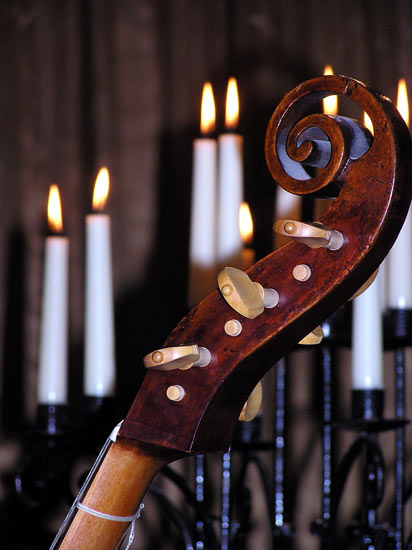|
Johann Sebastian Bach Die Sonaten für Viola da gamba und Cembalo |
 |
|
Johann Sebastian Bach Die Sonaten für Viola da gamba und Cembalo |
 |
Konzert-Seminar"Als wenn die ewige Harmonie sich mit sich selbst unterhielte, wie sich's etwa in Gottes Busen, kurz vor der Weltschöpfung, möchte zugetragen haben."
("As if the eternal Harmony would converse with itself, as it may have happened in God's bosom, on the dawn of the Creation of the World")Thus spoke Goethe upon hearing a work by Bach. Many listeners today may undergo that same uncanny experience. Viewed historically, it is thanks to the artistic greatness of Johann Sebastian Bach that old music underwent a rebirth during the early 19th Century, which has not abated even today: his music never fell in total oblivion. On the other hand it is because of the prevailing interest in old music that the works of this composer are so frequently heard in church and concert hall. Bach's creations may indeed be considered undisputedly to be the starting point of traditional - i.e. classical and romantic - music; nevertheless, if one wishes to come to grips with Bach, one must understand him to be rather the culmination of a spiritual-philosophical epoch. Only the philosophical thought of this epoch - the Baroque - deciphers for us the inherent values of this art form, a very intellectual one, which is designed to convey to the listener affects and passions of the human essence.
Through the detailed study of the three sonatas for obligato harpsichord and viola da gamba insights may be gained into the compositional methods, the lines of thought and the inner functioning's of this baroque musical language, by which the modern listener may unravel the meanings intertwined in these rhetorical figures familiar to Bach's contemporaries.
Although the extant manuscript sources yield practically no clues as to the exact date of composition, these sonatas were most likely conceived in Coethen, alongside the bulk of his instrumental legacy. At court Bach dedicated himself almost exclusively to the composition of chamber music, after his efforts to create a "proper" church music were effectively thwarted by the intellectual intolerance and bigotry towards art of the religious authorities - of pronounced pietistic conviction - of his previous church posts. In Coethen a small but outstanding ensemble of musicians stood at Bach's disposal, which could do justice to his demanding compositions. Even his aristocratic master, Prince Leopold, played both harpsichord and viola da gamba passionately: yet another ground to suspect that these sonatas came to life in Coethen. If Leopold reached for the viol, Bach could readily accompany him on the keyboard; if instead, the prince chose to play the latter, the excellent court violist da gamba, Christian Ferdinand Abel, stood in the service of His Majesty.
These fortunate historical circumstances destined that these meaningful and poetical works should be handed down to us. The variety of musical forms, the richness of expression inherent in this language will be analysed in this concert - seminar.The commentary will illustrate the following points:
- the instruments and their sound characteristics
- the sources: the 19 manuscripts of the three sonatas
- Tonartcharakteristika: the character of the keys
- sonata and concerto forms in these works
- "Figurenlehre": the doctrine of the musical figures and their symbols
- relevant aspects of performance practice
Borbála Dobozy und José Vázquez, Budapest, 21. Februar, 2004
Fotodokumentation
Die Sammlung
Unsere Aktivitäten
updated16.03.2011